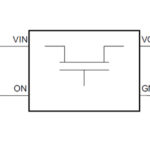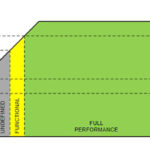Part 1 of this FAQ discussed the context of overvoltage protection and crowbars which provide OVP. This part will look at clamps for OVP use.
Q: What does the clamp do?
A: A clamp conducts just-enough current to maintain the voltage across it at a safe, desired value when the transient is above the clamp’s conduction voltage. It must be rated for the power it will have to dissipate for a specific time, usually a relatively short transient event.
Q: How can a clamp be implemented?
A: There are several ways. Among the most common is using a metal oxide varistor (MOV), a bidirectional semiconductor voltage-transient suppressor device, Figure 1. It conducts (i.e., switches) at a voltage related to the size and number of special grains between its leads. MOV breakdown voltages range from about 14 V to over a thousand volts, with the larger ones intended for handling several kilovolt-amps (kVA) such as from a lightning surge.


Q: What are some of the general attributes of MOVs?
A: MOVs are low cost, fast acting, easy to use, are offered in many voltage ratings, and their own failure mode is to short circuit (which is preferred in most fail-safe designs). However, they have moderate self-capacitance, which limits their use to power supplies (and low-speed data lines), and they can only dissipate small amounts of power, so they are suited only to short-term and transient OVP situations.
Q: What about the Transient Voltage Suppressor?
A: The Transient Voltage Suppressor (TVS) is also a silicon clamping device and is available with breakdown voltages from 4 to 500 volts, and in various power ratings to provide different surge-protection capabilities, Figure 3. A TVS device is a bipolar junction device and is similar to a basic rectifier diode but designed to survive reverse breakdown voltage situations.

Q: Can an ordinary diode or a Zener diode be used as a clamp?
A: In theory, yes. But performance is not consistent, specifications are very sensitive to temperature and operating conditions, and ratings are not suitable in many cases. Therefore, they should not be used except in an “emergency” or carefully considered circumstances.
Q: Why do you even need these; won’t a fuse (or circuit breaker) alone provide the same protection?
A: A fuse (or its sibling, the circuit breaker) is a valuable and reliable circuit-protection component but serves a different function. A fuse protects a system and supply from excess current flow, as may occur when the load has an internal short, or a component short circuits: the fuse “opens” and thus interrupts the current flow before the supply has a chance to go into overload and literally “blows” some of its components, or tries to deliver excess current to the load.
In brief, the fuse is a current-driven device, while the crowbar and the clamp are voltage-driven. The fuse protects the supply from damage due to the load faults, while the crowbar and clamp protect a load from supply faults. It’s common to use both a fuse plus a crowbar and/or clamp in many applications. Also, a crowbar or clamp can react in microseconds or milliseconds while a fuse cannot act as fast, as the fuse must react thermally (although electronic fuses do overcome this speed of response issue).
Q: I’m confused: are we talking voltage or current here?
A: Both, of course, since voltage and current are related. If there is a voltage present, there may also be a flow, and their product is power and thus heat. The power rating of the OVP device must be kept in mind, or else it can overheat or become overstressed prematurely and become a fault itself, and an OVP device which has faulted in a very unpleasant occurrence.
Q: How do I decide what to use?
A: There is no simple answer. In general, crowbars are better for long-term faults, while clamps are best-suited for transient events rather than outright supply failures. Many commercial power supplies incorporate both a crowbar and a clamp. If the concern is an outright failure and associated high-current flow which would soon overwhelm the dissipation rating of the crowbar or clamp, the design should also include a fuse or circuit breaker. The fuse/breaker will eventually blow from the overcurrent related to the excess voltage and so provide multi-factor protection.
References (all EEWorld Online)
Why use an e-fuse? Part 1
e-Fuses, Part 2: Building or buying an e-Fuse
Fuses for power protection, Part 1
Fuses for power protection, Part 2
Load switches, Part 1: Basic role and principle
Load switches, Part 2: IC implementations and benefits
Programmable electronic fuse sustains 4 A over 8 to 48-V range
Fuses that blow safely
Six considerations for better circuit protection
Basics of power-supply self-protection
Varistors include fuse protection
Radial leaded MOVs for general purpose overvoltage protection
Other References
Microsemi Corp, MicroNote 106, “Crowbars and Clamps: What Are Their Major Differences?
Sunpower Electronics Ltd, “What is Over Voltage Protection?
Bourns, Inc., “Transient Overvoltage Protection”









[…] Part 2 of this FAQ will look at a complementary OVP device, the clamp, in more detail. […]